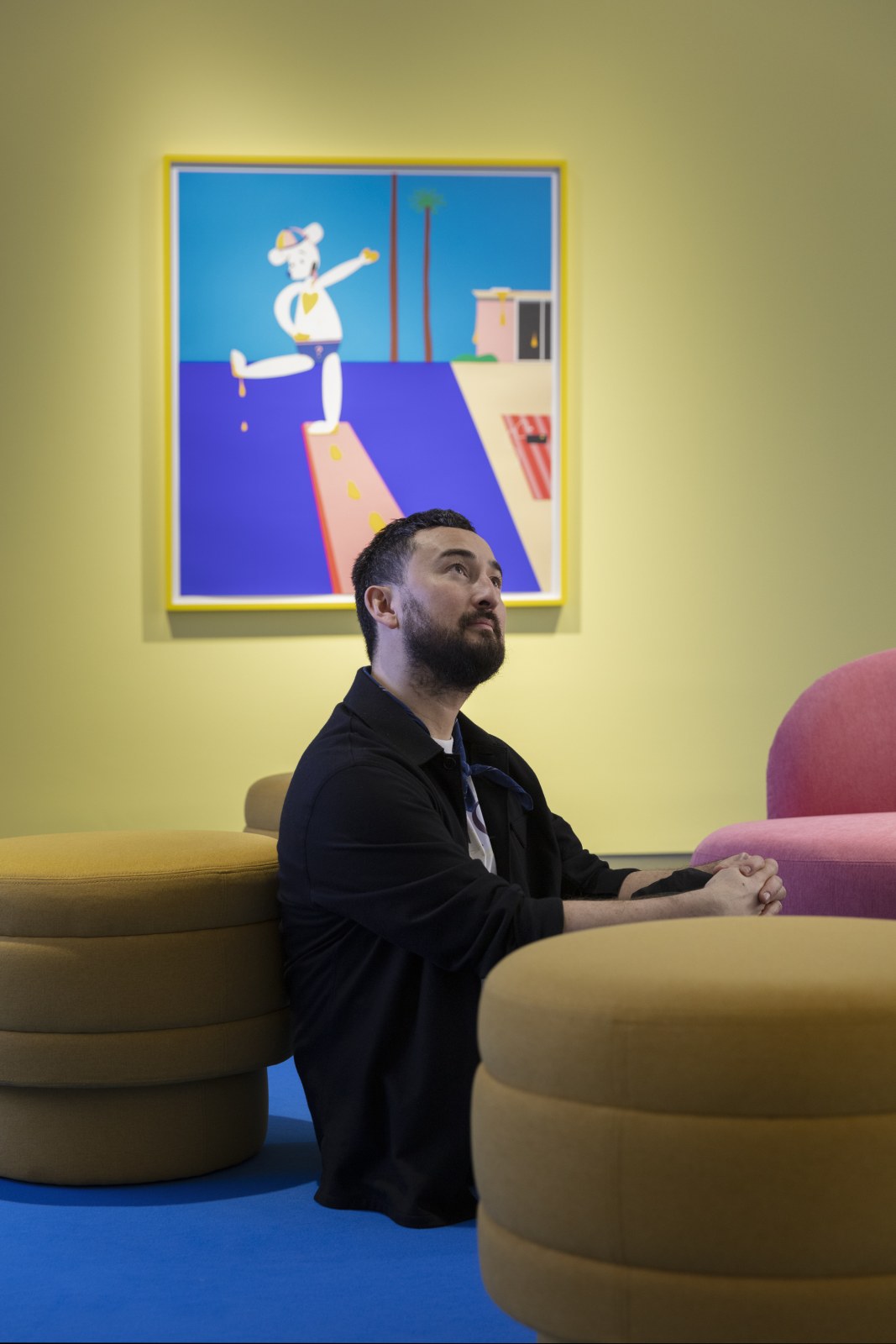Simon Fujiwara

Simon Fujiwara is a British-Japanese artist, born in 1982 in London, living and working in Berlin.
At the core of the work of Simon Fujiwara is a question - what does it mean to be a ‘Self’ in the 21st century? With humour, inventiveness, delight and rigor, his works reflect on existential quandaries such as: how should one construct a self today? How has technology altered our identities? Is there such thing as an authentic ‘me’?
From performative lectures, video installations and paintings, to the creation of entire themed ‘worlds’, his decade long practice employs a range of artistic strategies that seek to expand our notions of race, gender, national and sexual identities in a world increasingly mediated through technology and images. Often employing and even parodying his own identity in his work, he confronts these potent cultural topics in unexpected ways - mining fields such as advertising or theme park design or drawing on art historical strategies from Dadaism to Pop and Conceptual art.
His work is informed by his early studies in architecture and operate as ‘imaginary structures’ in which ethical and moral conundrums can coexist with the fantastical, surreal and absurd. As such, his work creates spaces in which disconcerting aspects of life under 21st century capitalism can be examined in a playful and even pleasurable way.
Fujiwara is the recipient of the 2010 Baloise Prize at Art Basel and the 2010 Frieze Cartier Award. He was shortlisted for the Preis der Nationalgalerie 2019.
Fujiwara’s recent solo exhibitions include: Simon Fujiwara: It’s a Small World, Kiasma, Helsinki (2024); Simon Fujiwara, Who the Bær, Prada Aoyama, Tokyo (2022-2023); Simon Fujiwara, Hello Who?, CIRCA Art, public screenings in London, Seoul, New York, Milan, Berlin, Melbourne, Los Angeles (2022); Simon Fujiwara, new work, Kunstinstituut Melly, Rotterdam (2021); Who the Bær, Fondazione Prada, Milan (2021); Hope House, Blaffer Art Museum, Dallas (2020–21); Joanne, Arken, Skovvej (2019); Revolution, Lafayette Anticipations – Fondation d’entreprise Galeries Lafayette, Paris (2018); Joanne, Galerie Wedding, Raum für zeitgenössische Kunst, Berlin (2018); Hope House, Kunsthaus Bregenz (2018); Joanne, The Photographers’ Gallery, London (2016); Figures in a Landscape, Kunsthalle Düsseldorf (2016); The Humanizer, Irish Museum of Modern Art, Dublin (2016); White Day, Tokyo Opera City Gallery, Tokyo (2016); The Way, Yu-un, Obayashi Collection, Tokyo (2016); Three Easy Pieces, The Carpenter Center, Harvard University, Cambridge (2014); Rebekkah, Contemporary Art Society, London (2014); Grand Tour, Kunstverein Braunschweig (2013); The Problem of the Rock, Dazaifu Tenmangu Shrine, Fukuoka (2013); 1982, Tate St. Ives, St. Ives (2012); Welcome to the Hotel Munber, Power Plant Contemporary Art Gallery, Toronto (2011); and The Personal Effects of Theo Grünberg, Julia Stoschek Collection, Dusseldorf (2010).
Among recent biennials and group exhibitions are: Elmgreen & Dragset: READ, Kunsthalle Praha, Prague (2023-2024); 8th Beijing International Biennale, Beijing (2023); Very Small Feelings, Kiran Nadar Museum, Delhi (2023); Semi Art Community: Boogie Woogie Art Museum, Ulsan Museum, Ulsan (2023); 6th Dhaka Art Summit, Dhaka (2023); LOVELOVELOVE Biennale of Moving Image, UCCA, Beijing (2022); something new, something old, something desired, Kunsthalle Hamburg (2022); Biennale de l’Image en Mouvement 2021 (BIM’21), Centre d'Art Contemporain Genève, Geneva (2021–22); It’s Just a Phase, Kjøpmannsgata Ung Kunst (KUK), Trondheim (2021–22); Gravity, Blitz, Valletta (2021); Intimacy: New Queer Art from Berlin and Beyond, Schwules Museum, Berlin (2020–21); State of the Arts, Bundeskunsthalle, Bonn (2020); Manual Override,The Shed, New York (2019); 16th Istanbul Biennial: The Seventh Continent, Antrepo 5, Istanbul (2019); Preis der Nationalgalerie 2019, Hamburger Bahnhof – Museum für Gegenwart, Berlin (2019); Distance Intime. Chefs-d'oeuvre de la Collection Ishikawa, MO.CO. – Montpellier Contemporain, Hôtel des Collections, Montpellier (2019); Our Happy Life: Architecture and Well-Being in the Age of Emotional Capitalism, Canadian Centre for Architecture, Montreal (2019); Is This Tomorrow?, Whitechapel Gallery, London (2019); Motherland in Art, Museum of Contemporary Art in Krakow (2018); Sur/Face: Mirrors, Museum Angewandte Kunst, Frankfurt am Main (2017); The Happy Museum, Berlin Biennale 9, Akademie der Künste, Berlin (2016); Joanne, Okayama Art Summit 2016, Okayama (2016); Storylines, Solomon R. Guggenheim Museum, New York (2015); Un Nouveau Festival, Centre Pompidou, Paris (2014); Sharjah Biennial, Sharjah (2013); Shanghai Biennial, Shanghai (2012); Gwangju Biennial, Gwangju (2012); São Paulo Biennial, São Paulo (2010); and the 53rd Venice Biennale, Venice (2009).
The artist’s work is represented in the collections of the American Embassy, London; Museum of Modern Art, New York; the Solomon R. Guggenheim Museum, New York; Tate, London; Museum of Contemporary Art, Tokyo; Hamburger Kunsthalle, Hamburg; Sammlung Verbund, Vienna; Sharjah Art Foundation, Sharjah; Centre Pompidou, Paris; The Prada Foundation, Milan; Leeds University, Leeds; and the Museum für Moderne Kunst, Frankfurt am Main.